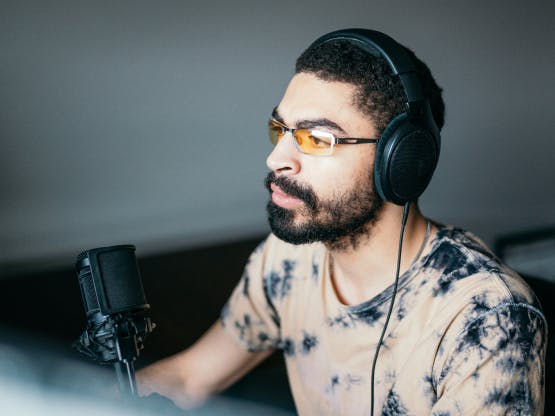Sonic Futures: Where Inspiration Meets Algorithm
The next era of audio creation isn’t trumpeted by neon “AI Inside” stickers. It’s the quiet, uncanny instant when your DAW suggests a riser you hadn’t dreamed of or turns a whispered scratch‑read into a stadium‑filling chant. Algorithms have moved from novelty to necessity, and the real question is simple: how early in the process will you invite them in?
Every minute that passes, another studio refactors its pipeline around AI‑assisted vocals, ambience generation, and self‑tuning mix tools. Let’s map out what that means for anyone shaping game or film soundscapes today.
2026: When Voice AI Stops Being a Party Trick
Two years ago, generative audio felt like R&D. Today, it’s a workflow. The GDC 2025 State of the Game Industry report says one in three developers already use Gen‑AI to speed up production passes, while Unity’s 2024 study clocks overall AI‑tool adoption at 62 % of teams. Film is catching up fast: A24’s awards‑season darling The Brutalist quietly used Respeecher to fine‑tune multilingual dialogue and shave months off post‑production.
Translation? If your dialogue or creature library still relies on traditional ADR or Foley timelines, you’re already behind schedule.
From Voice Cloning to Texture Synthesis: A Quick Tour of AI‑Assisted Audio Tools
Voice AI is only one branch on a fast‑growing tree of algorithmic helpers. In 2025, most professional studios juggle a handful of specialized tools:
- Voice cloning & style transfer tools like SoundID VoiceAI lets you sculpt timbre, gender, and emotional tone offline, right inside Pro Tools, Ableton, Logic, or Reaper. No cloud, no NDAs, and after a 7‑day trial it’s yours with a one‑time, perpetual license.
- Text‑to‑speech & localization accelerators – solutions like ElevenLabs, Respeecher, and Replica automate scratch ADR or regional accents.
- Text‑to‑SFX sketch pads – Adobe Sketch2Sound and Krotos Studio convert typed prompts or hummed ideas into Foley layers you can tweak.
- AI‑assisted mixing & repair – iZotope RX Music Rebalance, Sonible smart:EQ, and SoundID Reference help tame clutter or match tonal targets at speed.
- Generative ambience & texture synths – tools such as Atlas or Emergent Drums spawn evolving beds and percussive hits seeded from your own library.
Throughout the rest of this article, we’ll lean on SoundID VoiceAI for voice manipulation examples, but the same signal flow applies to any DAW‑native generator – swap to taste.
Four Trends Driving the Stampede Driving the Stampede
| Trend | Why It Matters | Stat to Flaunt |
| Prototype Velocity | Designers iterate NPC barks or monster call‑outs during play‑tests, not weeks later. | 71 % of AI‑adopting teams say gen‑audio improved delivery speed |
| Localization Crunch | AI accent matching slashes costly re‑takes. | The Brutalist trimmed an 18‑month post by “months” thanks to voice cloning |
| Player Personalization | Dynamic dialogue that mirrors the avatar’s chosen voice keeps retention high. | 1 in 3 AAA titles plan adaptive voice systems by 2026 |
| Creator‑First Tools | Text‑to‑SFX like Adobe’s Sketch2Sound lets you hum a Foley pass. | Sketch2Sound demo shows vocal‑to‑SFX generation for Foley artists |
It’s tempting to file these stats away for “next project,” but competitive dev houses and post studios are already re‑tooling. The good news? You don’t need a PhD in ML to join them. A modern DAW, a GPU‑friendly plug‑in and a sprinkle of imagination are all it takes to sound future‑proof.
Now, let’s open the session and get practical.
The Craft: Making Voices Feel Alive in Linear and Interactive Worlds
“My actors were asleep, but my orcs were screaming.” — a Discord message from a junior sound designer at 2:47 a.m.
That vibe – creative sparks flying long after the ADR booth lights are out – is exactly what DAW‑native voice AI enables. Below are four staple scenarios, each followed by a conversational “try‑this‑tonight” breakdown so you can feel the difference before breakfast.
1. Creature Vocal Stacks Without Mud
What the audience hears: A nine‑foot lizard that rattles stadium subs yet still cuts through a crowded mix.
How you build it:
- Clone a single scream three times.
- Pitch‑shift: −7 semitones (body), +3 semitones (snarl), −12 semitones (sub‑growl).
- Formant‑shift ±400 cents to avoid chipmunk artifacts.
- Low‑pass the sub‑growl at 300 Hz; send the snarl to a bright plate.
Why it works: Contrast + cohesion – no masking the cinematic boom.
2. Instant ADR Scratch‑Track
Problem: Editor needs temp dialogue by morning.
Fix: Feed yesterday’s Zoom rehearsal into the plug‑in, match the on‑set boom mic’s IR, print and drag into the timeline.
Pro‑tip: Snapshot presets for “lav vs boom” to trade tonal balance in one click.
3. Real‑Time NPC Prototyping in Wwise
Setup: Route the plug‑in through Wwise Authoring API; map “Age,” “Alienness” and “Mood” to RTPCs.
Play‑test magic: Designers shift VO parameters mid‑battle, hearing changes instantly – no round‑trip to audio.
Experiment: Tie “Alienness” to enemy health so voices degrade as creatures take damage.
4. Trailer Voice‑Over Morphs
Narrative arc: Trailer begins sincere, glitches during plot twist, ends heroic.
Automation: Wet/Dry blend from 0 % to 60 % robotic, snap back to 10 % warmth for logo sting.
Audience reaction: Emotional clarity – even on phone speakers.
Workflow Playbook: Deep‑Dive Tactics & Experimental Layers
Bookmark this; it’s the blueprint the cool kids will steal from your Git repo.
| Stage | Tactical Moves | Experimental Layers |
| 1 · DAW Session | • Record or import dialog | • Non‑human phrasing: automate breath‑gate for rhythmic hyperventilation |
| • Run SoundID VoiceAI: choose core timbre, add style modulation (grit, air, vocal‑fry) • Print stems in place | • Feed stems into vocoder side‑chain with synth pads for musical VO | |
| 2 · Middleware (Wwise/FMOD) | • Import stems; create Switch Containers for languages, emotional states | • Glue VO to environment reverb by auto‑selecting IR based on room size variable |
| • Use plug‑in’s parameter IDs as RTPCs | • Procedural “aging” system: randomly trigger formant lift for juvenile NPC variants | |
| 3 · Game/Engine (Unreal/Unity) | • Bind “StressLevel” variable to pitch & gain • Pre‑cache voice models to avoid runtime hitches. | • Crowd‑source easter‑egg voices: pull Gen Z influencer lines via API, real‑time clone for dynamic shout‑outs • Blend masc/fem formants based on player choices to heighten narrative agency. |
| 4 · Version‑Control (Perforce/Git‑LFS) | • Commit printed audio plus JSON presets; store large model weights in LFS. • Tag commits by milestone for effortless rollbacks. | • Spin a marketing‑trailer branch: tweak timbre for promo without touching the main storyline repo. |
| 5 · Dub Stage / Final Mix | • Re‑render high‑resolution AI passes for theatrical stems. • Blend AI dialogue with human ADR for maximum nuance. | • Transform actor breaths into riser FX via Voice‑to‑Instrument; layer quietly under flashback scenes for subliminal tension. |
Midnight Experiments Worth Losing Sleep Over
- Voice‑to‑Instrument Sorcery: Bounce a villain monologue through the Voice‑to‑Viola mode; stretch 800 % and reverse – the result is a bowed‑metal texture perfect for tension beds.
- Counterpoint Conversations: Double the protagonist’s internal monologue with a whisper‑thin clone panned wide – creates subconscious unease without extra lines.
- Dynamic Gender Bending: In romance endings, blend masc/fem formants based on player choices; Gen Z testers report higher emotional resonance.
The Future: Gen Z, Character Creation & the Rise of Playable Voices
Gen Z grew up toggling Snap filters and TikTok voiceovers in seconds; they expect the same immediacy from games and films. We’re moving toward “player‑editable” voices – imagine character creators where sliders for pitch, accent and emotional intensity are as normal as hair color.
Meanwhile, directors will audition sonic personas the way they currently swipe through LUTs – audible look‑books that shift a character’s vibe in real time. Libraries won’t be static WAV folders but living catalogs of ethically sourced human timbres updated quarterly.
Why Ethics & Authenticity Will Matter More
Voice deepfakes made headlines in 2024; the backlash trained consumers to sniff out “AI gimmicks.” Tomorrow’s tools must prove chain‑of‑custody and respect for talent. The winners will be those who license real vocalists, pay them, and keep provenance metadata baked‑in.
Where SoundID VoiceAI Fits In (and Why You’ll Want It Tonight)
SoundID VoiceAI is Sonarworks’ answer to exactly these challenges:
- Try First, Decide Later: 7‑day fully unlocked trial, no watermarks, no export limits.
- Own It Forever: One‑time payment gets you a perpetual license; you’re free from recurring cloud fees.
- DAW‑Native & Offline: Stay creative even on an airplane; your dialogue never leaves the project folder.
- Growing Voice Catalog: Real singers, ethically sourced and compensated; new characters added monthly.
- Beyond Dialogue: Flip any vocal into instruments or ambient textures using Voice‑to‑Instrument modes – perfect for late‑night epiphanies.
Ready to chase that 3 a.m. lightning? Download the trial, load the plug‑in on your go‑to DAW track and push one button – your next monster, hero or kinetic riser is already hiding in your own voice.




